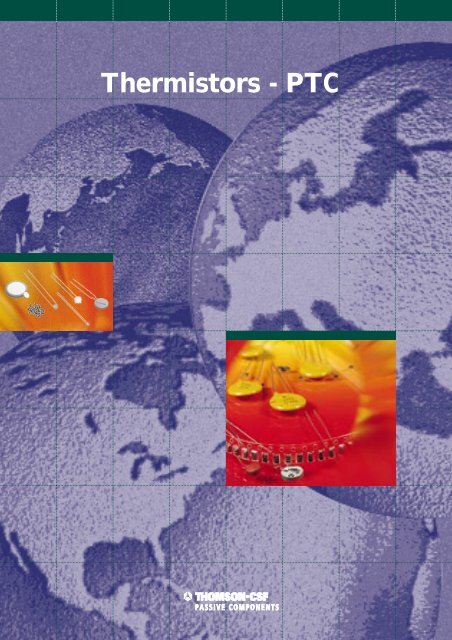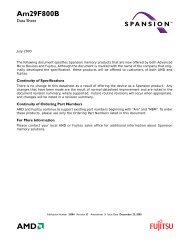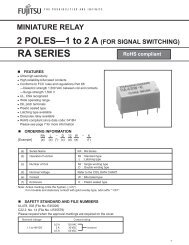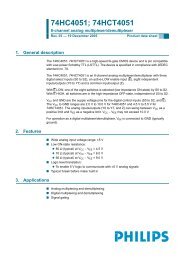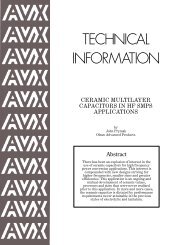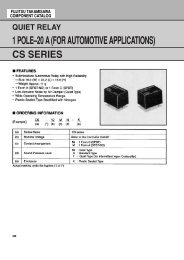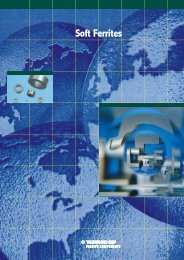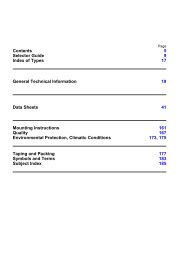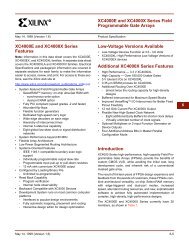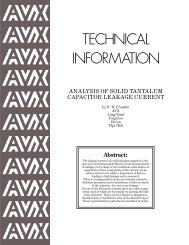PTC Thermistors - RYSTON Electronics sro
PTC Thermistors - RYSTON Electronics sro
PTC Thermistors - RYSTON Electronics sro
You also want an ePaper? Increase the reach of your titles
YUMPU automatically turns print PDFs into web optimized ePapers that Google loves.
<strong>Thermistors</strong> - <strong>PTC</strong>
<strong>PTC</strong> <strong>Thermistors</strong><br />
39
<strong>PTC</strong> Electrical characteristics<br />
1 – RESISTANCE - TEMPERATURE CHARACTERISTIC (Log R T – T)<br />
A positive Temperature Coefficient (<strong>PTC</strong>) thermistor is a resistor, mainly composed of solid solutions of baryum and<br />
strontium titanates. The addition of dopants makes the component semiconductive and gives it the typical resistance -<br />
temperature characteristic shown in figure 18.<br />
The <strong>PTC</strong> exhibits a slight negative temperature coefficient over the normal temperature range, a sharp rise in resistance<br />
around the Curie point and, at higher temperature, the coefficient becomes negative again.<br />
Zero power resistance at 25°C (R 25°C )<br />
The zero power resistance (R 25°C ) is the resistance value<br />
measured at 25°C in such conditions that the change in<br />
resistance due to the internal generation of heat is negligible<br />
with respect to the total error of measurement.<br />
RESISTANCE (Ω)<br />
Minimum resistance (R min )<br />
R min is the minimum zero power resistance of the resistance<br />
- temperature characteristic. It is measured at the<br />
temperature T where the temperature coefficient becomes<br />
positive.<br />
1000 000<br />
100 000<br />
Switching temperature (T b )<br />
The switching temperature is defined as the temperature<br />
at which the resistance R is twice the minimum resistance<br />
R b = 2 R min<br />
This temperature corresponds to the beginning of the switching<br />
ot the thermistor and is physically related to the transition<br />
temperature or Curie point.<br />
Temperature coefficient of resistance (α)<br />
10 000<br />
1000<br />
Rb<br />
R25°C<br />
R min<br />
The temperature coefficient of resistance α is the value of<br />
the slope of the resistance - temperature curve between<br />
the switching temperature T b and any other temperature<br />
T p greater than T b and located in the increasing resistance<br />
range. Thus, the coefficient, expressed in %/°C, is :<br />
10<br />
0 25 TR min Tb<br />
50 100 150 200<br />
TEMPERATURE (°C)<br />
α =<br />
100<br />
l n (R p / R b )<br />
Tp – Tb<br />
Figure 18 - Resistance - Temperature characteristic<br />
of <strong>PTC</strong> thermistors<br />
40
<strong>PTC</strong> Electrical characteristics<br />
2 – CURRENT-VOLTAGE CHARACTERISTIC<br />
The static current-voltage curve defines the relationship between the applied voltage and the obtained current when<br />
the thermistor is in a thermal equilibrium state (the Joule - effect heating is balanced by external heat dissipation).<br />
The curve exhibits two zones, as shown in figures 19 and 20 :<br />
- As the voltage increases from zero, the current and the temperature rise until the thermistor reaches the switch<br />
point. The I-V curve is approximately a straight line, the resistance is almost constant.<br />
- A further increase of voltage leads to a lower current, resulting in a constant-power dissipation area.<br />
100<br />
I (mA)<br />
I (mA)<br />
100<br />
50<br />
10<br />
T 1<br />
T 2<br />
T3<br />
T 1 >T 2 >T 3<br />
10<br />
20 30<br />
V (volts)<br />
40<br />
50<br />
1<br />
1 10 100 1000<br />
V (volts)<br />
Figure 19 - Current-voltage characteristic of<br />
<strong>PTC</strong> thermistors (linear scale)<br />
Figure 20 - Current-voltage curves at different<br />
ambient temperatures (Log-Log scale)<br />
The current-voltage characteristics are described by the following terms :<br />
Maximum voltage (U max )<br />
U max is the maximum voltage that can be applied<br />
continuously to the thermistor to guarantee the long<br />
term stability.<br />
Operating temperature range<br />
This is the range of ambient temperature at which the<br />
thermistor can operate continuously at the maximum<br />
voltage.<br />
Residual current (I res )<br />
With an operating temperature of 25°C, Ires is the residual<br />
current when the maximum rated voltage is applied.<br />
Maximum overload current (I mo )<br />
This is the maximum in-rush current that can be accepted<br />
by the thermistor.<br />
It may be necessary to limit the current through the thermistor<br />
by the use of a series resistor R s .<br />
Tripping current (I t )<br />
It is the minimum current value required by the thermistor<br />
to trip from its conductive state at ambient temperature<br />
(25°C) to its protective high resistance state.<br />
Non - tripping current (I nt )<br />
This is the maximum current value for which the thermistor<br />
is guaranteed to stay indefinitely in its conductive state.<br />
41
<strong>PTC</strong> Electrical characteristics<br />
3 – CURRENT - TIME CHARACTERISTIC<br />
When the applied voltage to a <strong>PTC</strong> thermistor exceeds the value that corresponds to the top of the I-V curve, the thermistor<br />
switches and its dynamic behaviour can be described by the current-time characteristic shown in figures 21<br />
and 22.<br />
Initially, a constant current flows, depending on the nominal resistance of the <strong>PTC</strong> (I = V/R), then the current decreases<br />
strongly as the thermistor changes to its non-conductive state. Finally, a low current balances external dissipation and<br />
assumes thermal equilibrium.<br />
The current-time curves depend strongly on the external conditions such as the applied voltage (figure 21) or the<br />
ambient temperature (figure 22).<br />
I (A)<br />
120 V<br />
110 V<br />
100 V<br />
I (A)<br />
60°C<br />
50°C<br />
25°C<br />
t (s)<br />
t (s)<br />
Figure 21 - Current-time characteristic of<br />
<strong>PTC</strong> thermistors - Voltage dependance<br />
Figure 20 - Current-time characteristic of <strong>PTC</strong><br />
Ambient temperature dependance<br />
The I-t curves also depend strongly on the thermal properties of the thermistors (volume, dissipation properties, ...)<br />
and can be clarified by the parameters hereafter :<br />
Heat capacity (H)<br />
H is the amount of heat required to increase the temperature<br />
of the thermistor by 1°C. The value of H is<br />
typically about 3 mJ/cm 3 /°C.<br />
Thermal time constant (τ)<br />
This is the time required for the temperature of a <strong>PTC</strong><br />
to change 63.2 % of the difference between its initial<br />
and final value when the conditions of the thermal equilibrium<br />
are changed. It is equivalent to the ratio H/δ.<br />
Dissipation factor (δ)<br />
This is the ratio of the power dissipated in the environment<br />
and the temperature difference between the thermistor<br />
and the ambient.<br />
δ is expressed in mW/°C as : δ =<br />
P<br />
T – Tamb<br />
where :<br />
P = V.I : power applied to the <strong>PTC</strong><br />
Tamb : ambient temperature<br />
T : temperature of a thermistor submitted to the<br />
power P<br />
These thermal characteristics can be used to describe approximately the dynamic behaviour of a <strong>PTC</strong> thermistor<br />
through the following heat balance equation :<br />
P dt = H dt + (T – Tamb) δ dt<br />
42
<strong>PTC</strong> Application notes<br />
MAIN <strong>PTC</strong> APPLICATIONS<br />
Characteristic Application Examples of use<br />
R (T)<br />
Temperature sensing<br />
Temperature control<br />
Over temperature protection<br />
Temperature compensation<br />
Temperature monitoring for heat<br />
sinks for power semi-conductors<br />
Household appliances.<br />
Thermal machine protection<br />
ICs, semiconductors<br />
audiovideo equipment<br />
V (I)<br />
Current overload protection<br />
Current control<br />
Self-regulating heating element<br />
Liquid level sensing<br />
Fluid flow sensing<br />
Constant current<br />
Telecommunication equipment<br />
Small transformers<br />
Motor circuit protection<br />
Dryers, heaters<br />
Carburettor preheating<br />
External mirror heating<br />
Automobiles<br />
Air blowers (failure detection)<br />
Battery chargers<br />
Time delay<br />
Timers<br />
Delayed switching of relays<br />
I (t) Motor starting Electric fans<br />
Degaussing<br />
Arc suppression<br />
Color TV sets<br />
Contact protection, switches<br />
43
<strong>PTC</strong> Application notes<br />
CURRENT OVERLOAD PROTECTION<br />
A <strong>PTC</strong> thermistor connected in series with an equipment<br />
can protect it when the current (or voltage or ambient<br />
temperature) exceeds a critical value (I 1 at T 1 or I 2 at T 2 )<br />
(figure 23).<br />
Under normal operating conditions, the current remains<br />
too low to heat the <strong>PTC</strong> above its switching temperature.<br />
If the current exceeds the critical value, the power dissipation<br />
results in heating the <strong>PTC</strong> to its switching temperature<br />
and reducing the current.<br />
When the fault conditions are removed, the <strong>PTC</strong> cools<br />
down and the current flows again.<br />
The <strong>PTC</strong> can be considered as a resettable fuse.<br />
I<br />
I 1<br />
I 2<br />
Rptc<br />
Equipment<br />
P 1<br />
T 1<br />
T 2 > T 1<br />
T 2<br />
P 2<br />
V<br />
Figure 23<br />
SELF-REGULATING HEATER<br />
Rptc<br />
Figure 24<br />
The functions of heater and thermostat can be cumulated<br />
when using a <strong>PTC</strong> thermistor (figure 24).<br />
Assuming a sufficient size for the <strong>PTC</strong> and appropriate<br />
dissipation and thermal bonding with the equipment, the<br />
Joule effect provides heating and the thermostat function<br />
is mainly related to the switching temperature of the thermistor.<br />
Furthermore, voltage or ambient temperature fluctuations<br />
are compensated for by an internal change of current and<br />
do not lead to a significantly different heating temperature.<br />
CONSTANT CURRENT<br />
By connecting a <strong>PTC</strong> in parallel with a resistor Rp, it is<br />
possible to obtain a nearly constant current Is through Rs<br />
over a broad voltage range.<br />
When the voltage Vo is increased, a very small increase<br />
of the <strong>PTC</strong> temperature results in a reduction in current<br />
through Rptc, compensating the increase of current<br />
through Rp (figure 25).<br />
Vo<br />
Rs<br />
Is, Vs<br />
Rptc<br />
IS = V O – VS (T<strong>PTC</strong> – Tamb)<br />
+ δ<br />
Rp VO – VS<br />
Rp<br />
Figure 25<br />
44
<strong>PTC</strong> Application notes<br />
MOTOR STARTING<br />
<strong>PTC</strong> thermistors can be used to protect auxiliary starter<br />
winding of induction motors or single-phase motors<br />
(figure 26).<br />
Rptc<br />
Auxiliary<br />
starter<br />
At switch-on, most of the line voltage can be applied to<br />
the starter winding as the resistance of the <strong>PTC</strong> is low.<br />
After motor starting, the current heats up the <strong>PTC</strong> to its<br />
switching temperature. The resistance of the <strong>PTC</strong> rises<br />
drastically and the current falls.<br />
I<br />
t<br />
Rptc<br />
Figure 26<br />
V<br />
R.L<br />
ARC SUPPRESSION<br />
The circuit displayed on figure 27 enables arc suppression.<br />
At switching-off, the current flows through the <strong>PTC</strong>.<br />
The <strong>PTC</strong> heats up and its resistance rises.<br />
t<br />
The voltage drop is progressively transfered from the<br />
inductive load to <strong>PTC</strong>, providing effective arc suppression.<br />
Figure 27<br />
TIME DELAY<br />
Rptc<br />
I<br />
The time necessary for the <strong>PTC</strong> to change from a<br />
conductive and low temperature state to a self-heated<br />
and high resistive state may be used to provide a time<br />
delay in an electronic circuit (figure 28).<br />
Relay<br />
Relay/<strong>PTC</strong><br />
t<br />
When a <strong>PTC</strong> is connected in series with a relay, the relay<br />
is immediately energized at switch-on and remains energized<br />
until the <strong>PTC</strong> heats up and reaches its switching<br />
temperature and high resistance state.<br />
Rptc<br />
I<br />
Relay<br />
Relay<br />
If the <strong>PTC</strong> is connected in parallel, the relay is energized<br />
only after a time delay due to the time necessary for heating<br />
the thermistor.<br />
<strong>PTC</strong><br />
t<br />
Figure 28<br />
45
Selection guide<br />
Types Maximum Switching Range of values Main applications Page<br />
voltage temperature<br />
Standard Series<br />
1.1 13<br />
PE 30 V 130°C 48<br />
- Current overload<br />
coated<br />
1.8<br />
100<br />
protection<br />
disc 130 V 110°C<br />
49<br />
3.7<br />
150<br />
PG 265 V 80°C 50<br />
- Over temperature<br />
leadlers<br />
3.7<br />
220 protection<br />
disc 265 V 120°C<br />
51<br />
Telecommunication<br />
series<br />
PE - PS<br />
leaded<br />
disc<br />
130/ Custom 10 70<br />
- Line and handset 54<br />
245 V design protection<br />
Automotive and<br />
industrial series<br />
PE<br />
- Overload protection<br />
Custom Custom - Delayed switching<br />
PS<br />
design design - Heating elements<br />
Leaded<br />
- Thermostats 53<br />
disc<br />
3 600<br />
- Temperature<br />
measurement and<br />
PG Example Example control<br />
leadless 12 V to 80 V 80°C to<br />
disc 140°C<br />
46
Characteristics of the metallized<br />
1 2 3 4 5 6 7 8 9 10 11 12 13<br />
P E 0 6 N N 0 1 0 1 X – –<br />
Type<br />
PE<br />
PG<br />
PS<br />
PV<br />
Size<br />
04<br />
06<br />
08<br />
10<br />
12<br />
16<br />
20<br />
Material<br />
code<br />
J : 80°C<br />
M : 110°C<br />
N : 120°C<br />
P : 130°C<br />
Voltage<br />
code<br />
B : 30 V<br />
G : 130 V<br />
N : 265 V<br />
Resistance at 25°C (EIA code)<br />
Resistance expressed by 2<br />
significant figures<br />
7 th digit : 0 (zero)<br />
8 th and 9 th digits : the 2<br />
significant figures of the resistance<br />
value at 25°C.<br />
10 th digit :<br />
– for values ≥ 10 Ω :<br />
the number of ZEROS to be<br />
added to the resistance values<br />
– for values ≥ 1 Ω and ≤ 9.9 Ω :<br />
the figure 9 signifying that the<br />
resistance value is to be<br />
multiplied by 0.1<br />
– for values < 1 Ω : the figure 8<br />
signifying that the resistance<br />
values is to be multiplied by<br />
0.01.<br />
Examples : 1000 Ω : 0102<br />
8.2 Ω : 0829<br />
0.47 Ω : 0478<br />
Suffix<br />
Tolerance<br />
on resistance<br />
at 25°C<br />
X : ± 25%<br />
Resistance expressed by 3 significant<br />
figures<br />
7 th, 8 th and 9 th digits : the 3<br />
significant figures of the resistance<br />
value at 25°C.<br />
10 th digit :<br />
– for values > 100 Ω :<br />
the number of ZEROS<br />
to be added to the resistance<br />
value<br />
– for values > 10 Ω and < 100 Ω :<br />
the figure 9 signifying that the<br />
resistance value is to be multiplied<br />
by 0.1<br />
– for values > 1 Ω and < 10 Ω :<br />
the figure 8 signifying that the<br />
capacitance value is to be multiplied<br />
by 0.01.<br />
Examples : 196 Ω : 1960<br />
47.2 Ω : 4729<br />
For specific types (telecommunication, automotive, industrial), see specification on pages 52 and 53.<br />
47
Disc <strong>PTC</strong> - Overload protection : PE - PG<br />
Maximum voltage : 30 V / Switching temperature : 130°C<br />
Well suited for overload protection and delayed switching, the <strong>PTC</strong> thermistors of the 30 V / 130°C series will be of particular<br />
interest in automotive and consumer applications.<br />
Types PE PG<br />
Finish<br />
Coated disc<br />
Leadless disc<br />
for soldering or clamping<br />
Dimensions (mm)<br />
D<br />
E<br />
30 min 3 max<br />
e<br />
4.5 mm ± 1mm<br />
d + 10 %<br />
- 0.05<br />
D<br />
Metallization<br />
e<br />
Marking Thomson logo / Rated resistance On packaging only<br />
Particular characteristics :<br />
Dimensions (mm)<br />
Rn Int* It* Imo Ires<br />
Reference ± 25 % at 25°C at 25°C at 25°C PE PG<br />
( ) (mA) (mA) (A) (mA) D max emax d E Dmax emax<br />
P■03 PB 0130 X -- 13 100 200 0.7 40 4.2 3.5 0.5 5 4 1.5<br />
P■04 PB 0130 X -- 13 125 250 1.5 40 5.3 4.5 0.6 5 4.8 3<br />
P■06 PB 0609 X -- 6 220 440 2 50 7.2 4 0.6 5 6.5 2.5<br />
P■08 PB 0409 X -- 4 300 600 3 60 9 4 0.6 5 8.2 2.5<br />
P■10 PB 0259 X -- 2.5 400 800 4.3 70 11 4 0.6 5 10.2 2.5<br />
P■12 PB 0189 X -- 1.8 500 1000 5.5 80 13 4 0.8 7.6 12 2.5<br />
P■16 PB 0119 X -- 1.1 800 1600 8 100 17.5 4 0.8 7.6 16.5 2.5<br />
*Int and It values are given for PE serie only. For PG serie, these values strongly depend on the assembly mode.<br />
■ = E for leaded disc<br />
■ = G for leadless disc<br />
Rn : Nominal resistance at 25°C<br />
Int : Maximum non tripping current<br />
It : Minimum tripping current<br />
Imo : Maximum overload current<br />
Ires : Residual current at V max (typical value)<br />
Type<br />
Size<br />
Material : P<br />
Voltage : 30 V<br />
Rn : 13 Ω<br />
Tolerance : X ± 25 %<br />
Ordering example<br />
PE 04 P B 0130 X - -<br />
48
Disc <strong>PTC</strong> - Overload protection : PE - PG<br />
Maximum voltage : 130 V / Switching temperature : 110°C<br />
These <strong>PTC</strong> thermistors are widely used to protect circuit component at the load and power supply sides (110-130 V)<br />
against overcurrent. They provide one of the most efficient solution to limit the current when abnormal energy flows<br />
through the circuit.<br />
Types PE PG<br />
Finish<br />
Coated disc<br />
Leadless disc<br />
for soldering or clamping<br />
Dimensions (mm)<br />
D<br />
E<br />
30 min 3 max<br />
e<br />
4.5 mm ± 1 mm<br />
d + 10 %<br />
- 0.05<br />
D<br />
Metallization<br />
e<br />
Marking Thomson logo / Rated resistance On packaging only<br />
Particular characteristics :<br />
Dimensions (mm)<br />
Rn Int* It* Imo Ires<br />
Reference ± 25 % at 25°C at 25°C at 25°C PE PG<br />
( ) (mA) (mA) (A) (mA) D max emax d E Dmax emax<br />
P■04 MG 0101 X -- 100 45 90 0.35 8 5.3 5 0.6 5 4.8 3.5<br />
P■04 MG 0700 X -- 70 50 100 0.4 8 5.3 4.5 0.6 5 4.8 3<br />
P■04 MG 0550 X -- 55 60 120 0.45 8 5.3 4.5 0.6 5 4.8 3<br />
P■04 MG 0350 X -- 35 75 150 0.5 8.5 5.3 4.5 0.6 5 4.8 3<br />
P■06 MG 0250 X -- 25 95 190 1 10 7.2 4.5 0.6 5 6.5 3<br />
P■06 MG 0150 X -- 15 125 250 1.3 10.5 7.2 4.5 0.6 5 6.5 3<br />
P■08 MG 0100 X -- 10 170 340 2 11.5 9 4.5 0.6 5 8.2 3<br />
P■10 MG 0709 X -- 7 210 420 2.8 14 11 4.5 0.6 5 10.2 3<br />
P■12 MG 0459 X -- 4.5 280 560 4.5 18 13 5 0.8 7.6 12 3<br />
P■16 MG 0309 X -- 3 400 800 7 25 17.5 5 0.8 7.6 16.5 3<br />
P■20 MG 0189 X -- 1.8 650 1300 11 30 22 5 0.8 7.6 21 3<br />
*Int and It values are given for PE serie only. For PG serie, these values strongly depend on the assembly mode.<br />
■ = E for leaded disc<br />
■ = G for leadless disc<br />
Rn : Nominal resistance at 25°C<br />
Int : Maximum non tripping current<br />
It : Minimum tripping current<br />
Imo : Maximum overload current<br />
Ires : Residual current at V max (typical value)<br />
49<br />
Type<br />
Size<br />
Material : M<br />
Voltage : 130 V<br />
Rn : 10 Ω<br />
Tolerance : X ± 25 %<br />
Ordering example<br />
PG 08 M G 0100 X - -
Disc <strong>PTC</strong> - Overload protection : PE - PG<br />
Maximum voltage : 265 V / Switching temperature : 80°C<br />
Designed for higher operating voltage (265 V), this <strong>PTC</strong> series offers a good protection of instrument inputs against overcurrent<br />
and is able to limit or control the temperature to around 80°C.<br />
Types PE PG<br />
Finish<br />
Coated disc<br />
Leadless disc<br />
for soldering or clamping<br />
Dimensions (mm)<br />
D<br />
E<br />
30 min 3 max<br />
e<br />
4.5 mm ± 1 mm<br />
d + 10 %<br />
- 0.05<br />
D<br />
Metallization<br />
e<br />
Marking Thomson logo / Rated resistance On packaging only<br />
Particular characteristics :<br />
Dimensions (mm)<br />
Rn Int* It* Imo Ires<br />
Reference ± 25 % at 25°C at 25°C at 25°C PE PG<br />
( ) (mA) (mA) (A) (mA) D max emax d E Dmax emax<br />
P■04 JN 0151 X -- 150 28 56 0.25 5 5.3 5 0.6 5 4.8 3.5<br />
P■04 JN 0101 X -- 100 35 70 0.25 5 5.3 5 0.6 5 4.8 3.5<br />
P■06 JN 0700 X -- 70 40 80 0.5 5 7.2 5 0.6 5 6.5 3.5<br />
P■08 JN 0250 X -- 25 75 150 0.9 6 9 5 0.6 5 8.2 3.5<br />
P■10 JN 0150 X -- 15 110 220 1.5 7 11 5 0.6 5 10.2 3.5<br />
P■12 JN 0100 X HB 10 135 270 2.2 8 13 5 0.6 5 12 3.5<br />
P■12 JN 0100 X -- 10 150 300 2.2 8 13 5 0.8 7.6 12 3.5<br />
P■16 JN 0609 X -- 6 200 400 3.5 12 17.5 6 0.8 7.6 16.5 4<br />
P■20 JN 0379 X -- 3.7 300 600 5 16 22 6 0.8 7.6 21 4<br />
*Int and It values are given for PE serie only. For PG serie, these values strongly depend on the assembly mode.<br />
■ = E for leaded disc<br />
■ = G for leadless disc<br />
Rn : Nominal resistance at 25°C<br />
Int : Maximum non tripping current<br />
It : Minimum tripping current<br />
Imo : Maximum overload current<br />
Ires : Residual current at V max (typical value)<br />
50<br />
Ordering example<br />
PE 12 J N 0100 X HB<br />
Type<br />
Size<br />
Material : J<br />
Voltage : 265 V<br />
Rn : 10 Ω<br />
Tolerance : X ± 25 %<br />
Suffix HB : lead spacing 5 mm
Disc <strong>PTC</strong> - Overload protection : PE - PG<br />
Maximum voltage : 265 V / Switching temperature : 120°C<br />
High performances and high quality of these thermistors enable them to meet the more demanding specifications for<br />
overload protection of 220-265 V supplied equipment : UL approved.<br />
Types PE PG<br />
Finish<br />
Coated disc<br />
Leadless disc<br />
for soldering or clamping<br />
Dimensions (mm)<br />
D<br />
E<br />
30 min 3 max<br />
e<br />
4.5 mm ± 1 mm<br />
d + 10 %<br />
- 0.05<br />
D<br />
Metallization<br />
e<br />
Marking Thomson logo / Rated resistance On packaging only<br />
Particular characteristics :<br />
Dimensions (mm)<br />
Rn Int* It* Imo Ires<br />
UL Reference ± 25 % at 25°C at 25°C at 25°C PE PG<br />
( ) (mA) (mA) (A) (mA) Dmax emax d E Dmax emax<br />
*<br />
P■04 NN 0221 X -- 220 35 70 0.25 5 5.6 5 0.6 5 4.8 3.5<br />
*<br />
P■04 NN 0151 X -- 150 45 90 0.25 5 5.6 5 0.6 5 4.8 3.5<br />
*<br />
P■06 NN 0121 X -- 120 52 104 0.5 6 7.2 5 0.6 5 6.5 3.5<br />
*<br />
P■06 NN 0101 X -- 100 58 116 0.5 6 7.2 5 0.6 5 6.5 3.5<br />
*<br />
P■06 NN 0700 X -- 70 65 130 0.5 6 7.2 5 0.6 5 6.5 3.5<br />
*<br />
P■06 NN 0680 X -- 68 65 130 0.5 6 7.2 5 0.6 5 6.5 3.5<br />
*<br />
P■08 NN 0550 X -- 55 80 160 0.9 8 9 5 0.6 5 8.2 3.5<br />
*<br />
P■08 NN 0470 X -- 47 85 170 0.9 8 9 5 0.6 5 8.2 3.5<br />
*<br />
P■08 NN 0450 X -- 45 85 170 0.9 8 9 5 0.6 5 8.2 3.5<br />
*<br />
P■08 NN 0350 X -- 35 90 180 0.9 8 9 5 0.6 5 8.2 3.5<br />
*<br />
P■08 NN 0330 X -- 33 90 180 0.9 8 9 5 0.6 5 8.2 3.5<br />
*<br />
P■08 NN 0250 X -- 25 100 200 0.9 8 9 5 0.6 5 8.2 3.5<br />
*<br />
P■08 NN 0220 X -- 22 105 210 0.9 8 9 5 0.6 5 8.2 3.5<br />
*<br />
P■10 NN 0150 X -- 15 135 270 1.5 9 11.5 5 0.6 5 10.2 3.5<br />
*<br />
P■12 NN 0100 X HB 10 180 360 2.2 10 13.5 5 0.6 5 12 3.5<br />
*<br />
P■12 NN 0100 X -- 10 225 450 2.2 12 13.5 5 0.8 7.6 12 3.5<br />
*<br />
P■16 NN 0689 X -- 6.8 300 600 3.5 16 17.5 6 0.8 7.6 16.5 4<br />
*<br />
P■16 NN 0609 X -- 6 310 620 3.5 16 17.5 6 0.8 7.6 16.5 4<br />
*<br />
P■20 NN 0479 X -- 4.7 400 800 5 20 22 6 0.8 7.6 21 4<br />
* P■20 NN 0379 X -- 3.7 460 920 5 20 22 6 0.8 7.6 21 4<br />
*Int and It values are given for PE serie only. For PG serie, these values strongly depend on the assembly mode.<br />
■ = E for leaded disc<br />
■ = G for leadless disc<br />
Rn : Nominal resistance at 25°C<br />
Int : Maximum non tripping current<br />
It : Minimum tripping current<br />
Imo : Maximum overload current<br />
Ires : Residual current at V max (typical value)<br />
51<br />
Type<br />
Size<br />
Material : N<br />
Voltage : 265 V<br />
Rn : 220 Ω<br />
Tolerance : X ± 25 %<br />
Ordering example<br />
PE 04 N N 0221 X - -
Disc <strong>PTC</strong> - Telecommunications series : PE - PS<br />
Approved by well known telephone manufacturers, these custom-designed <strong>PTC</strong> thermistors are widely used to protect<br />
supplying current circuits and calling detection systems.<br />
High reliability, precisely defined operating parameters make these <strong>PTC</strong> thermistors high quality components for circuit<br />
protection in severe environmental conditions.<br />
D<br />
e<br />
Packaging : on tape and reel.<br />
Quantity : 1500 parts per reel.<br />
d +10 %<br />
- 0.05<br />
E<br />
Particular characteristics :<br />
Reference<br />
V max Rn Tolerance<br />
Rms<br />
on Rn<br />
Dimensions (mm)<br />
Dmax emax d E Finish<br />
PS 06 N - 0005 --- 130 70<br />
+ 10 %<br />
- 15 %<br />
6.4 4 0.6 5 Uncoated<br />
PS 06 N - 0015 --- 245 70<br />
+ 10 %<br />
- 15 %<br />
6.4 4 0.6 5 Uncoated<br />
PE 10 -- 0019 --- 245 16 ± 25 % 11 4.5 0.6 5 Coated<br />
PE 10 -- 0020 --- 245 10 ± 20 % 11 4.5 0.6 5 Coated<br />
PS 08 -- 0021 ---* 245 25 ± 15 % 8.3 4 0.6 5 Uncoated<br />
PE 08 -- 0022 --- 245 25 ± 25 % 9 5 0.6 5 Coated<br />
* per reel ³R = 1 max<br />
Individual data sheet : upon request<br />
Ordering example<br />
PE 10 - - 0020 - - -<br />
Type<br />
LCC P/N<br />
52
Industrial and automotive <strong>PTC</strong> thermistors<br />
Ceramic <strong>PTC</strong> thermistors are used today in a wide range of applications including current overload protection, delayed<br />
switching, temperature measurement and control, heating elements and thermostats.<br />
Depending on the application, the shape, dimensions and electrical characteristics may be designed in different ways.<br />
We give below some non-limiting examples of designs applying to specific applications which illustrate our expertise in<br />
meeting any of your requirements.<br />
Types<br />
Type PE PS PG<br />
Finish Resin-coated disc uncoated disc Leadless disc<br />
Dimensions<br />
D<br />
e<br />
D<br />
e<br />
35 min<br />
ø 0.6 + 10%<br />
- 0.05<br />
5.08<br />
Overload protection - Delayed switching<br />
Type<br />
Diam. (D) Thick. (e) V max R25°C ³R25°C Tb Int It Imo Ires tb<br />
(mm) (mm) (V) (Ohms) (%) (°C) (mA) (mA) (A) (mA) (s)<br />
PV 08 -- 1007 --- 9 max 3.5 max 20 1.8 25 125 450 900 2.5 80 10<br />
PE 06 -- 1020 --- 6.5 max 3 max 30 3.0 25 140 400 600 4.5 50 0.260<br />
PE 04 -- 1019 --- 5 max 3 max 30 6.0 25 140 270 400 2.5 45 0.230<br />
PE 06 -- 1021 --- 8 max 5 max 30 8.2 20 115 180<br />
PE 08 -- 1031 --- 9 max 3.5 max 80 9.4 25 110 150 300 1.3 20 3<br />
PE 04 -- 1032 --- 6.5 max 3.5 max 40 125 25 110 40 80 0.35 8<br />
PE 04 -- 1041 --- 6.5 max 5 max 420 600 25 120 20 40 0.2<br />
Heating elements and thermostats – Measurement and control<br />
Type<br />
Diam. (D) Thick. (e) V max R25°C ³R25°C T1 R1 T2 R2 T3 R3<br />
(mm) (mm) (V) (Ohms) (%) (°C) (Ohms) (°C) (Ohms) (°C) (Ohms)<br />
PG 08 -- 1008 --- 8.0 + 0.5 1.0 + 0.2 30 8.0 25 105 2R25°C<br />
- 0.1<br />
PG 08 -- 1017 --- 8.0 + 0.5 1.0 ± 0.1 30 8.0 25 75 2R25°C<br />
PG 08 -- 1015 --- 8.0 + 0.5 1.2 + - 0.1<br />
0.2 12.5 16 90 1 k 125 >20 k<br />
PS 06 -- 1005 --- 7 max 2.5 max 30 12.5 20 50 2R25°C 100 >1 k<br />
PS 04 -- 1009 --- 4.7 ± 0.3 1.05 ± 0.3 80 25.0 25 95 2R25°C<br />
PV 04 -- 1014 --- 5.5 max 3.5 max 12 80.0 25 80 200 125 >6 k<br />
Individual data-sheet, marking, lead configuration, packaging, ... upon request.<br />
53
Resistance - Temperature characteristics<br />
RESISTANCE (Ω)<br />
30 V / 130°C RANGE<br />
RESISTANCE (Ω)<br />
130 V / 110°C RANGE<br />
TEMPERATURE (°C)<br />
TEMPERATURE (°C)<br />
RESISTANCE (Ω)<br />
265 V / 80°C RANGE<br />
RESISTANCE (Ω)<br />
265V / 120°C RANGE<br />
TEMPERATURE (°C)<br />
TEMPERATURE (°C)<br />
54
Current - Voltage characteristics<br />
30 V / 130°C RANGE<br />
Current (mA)<br />
1000<br />
130 V / 110°C RANGE<br />
Current (mA)<br />
100<br />
100<br />
10<br />
10<br />
0,1 1 10 100 1000<br />
Voltage (Volts)<br />
1<br />
0,1 1 10 100 1000<br />
Voltage (Volts)<br />
Current (mA)<br />
10000<br />
Current (mA)<br />
1000<br />
1000<br />
100<br />
100<br />
10<br />
0,01 0,1 1 10 100 1000<br />
10<br />
0,1 1 10 100 1000<br />
Voltage (Volts)<br />
Voltage (Volts)<br />
265 V / 80°C RANGE<br />
Current (mA)<br />
1000<br />
265 V / 120°C RANGE<br />
Current (mA)<br />
100<br />
100<br />
10<br />
10<br />
1<br />
0,1 1 10 100 1000<br />
1<br />
0,1 1 10 100 1000<br />
Voltage (Volts)<br />
Voltage (Volts)<br />
Current (mA)<br />
1000<br />
Current (mA)<br />
1000<br />
100<br />
100<br />
10<br />
1<br />
0,1 1 10 100 1000<br />
10<br />
0,1 1 10 100 1000<br />
Voltage (Volts)<br />
Voltage (Volts)<br />
55
Manufacturing process for <strong>PTC</strong> <strong>Thermistors</strong><br />
Incoming goods<br />
Weighing : every batch<br />
Powder preparation<br />
Powder testing<br />
Every batch by sampling. Resistance/temperature characteristic,<br />
voltage/current characteristic, physical characteristics<br />
Pressing<br />
Weight, thickness, visual inspection : every batch by sampling<br />
Sintering<br />
Thermal cycle : every batch<br />
Electrical test<br />
Every batch by sampling. Resistance/temperature characteristic,<br />
voltage/current characteristic, physical characteristics<br />
Metallization<br />
Visual inspection : every batch<br />
Soldering<br />
Visual inspection : every batch<br />
Cleaning<br />
Coating<br />
Thermal cycle, visual inspection<br />
Marking<br />
Visual inspection : every batch<br />
Polymerization<br />
Thermal cycle : every batch<br />
Lead cutting<br />
Final control Electrical : every batch 100 %<br />
Quality control<br />
Every batch by sampling : visual inspection, dimensions,<br />
resistance, voltage withstanding<br />
Packaging<br />
Bulk - on tape<br />
Quality acceptance<br />
Every batch : QA report<br />
Shipping consignment<br />
Outgoing shipping - Inspection<br />
Every batch, every shipment : packaging, documentation<br />
56
<strong>PTC</strong> Reliability<br />
Test Conditions of test Performance requirements<br />
Robustness of terminations Tensile strength : 10 N No visual damage<br />
bending : 5 N ³R/R < 5 %<br />
Solderability 235°C ± 5°C 2 s > 95 % of the surface of the lead<br />
wires covered<br />
Resistance to soldering heat 260°C ± 5°C 10 s No visual damage<br />
³R/R < 5 %<br />
AUTOMOTIVE AND TELECOMMUNICATION PROTECTION<br />
Endurance at maximum 1000 h/155°C No visual damage<br />
operating temperature ³R/R < 10 %<br />
at zero-power dissipation<br />
Intermittent load life 150 cycles No visual damage<br />
at maximum power 1 mn ”off” 9 min ”on” ³R/R < 10 %<br />
at Imax and Vmax<br />
Damp heat, steady-state 85°C 85 % R.H. No visual damage<br />
56 days ³R/R < 10 %<br />
Salt spray 96 h 35 ± 2°C No visual damage<br />
salt concentration 5 % ³R/R < 7 %<br />
INDUSTRIAL PROTECTION<br />
Endurance at maximum 1000 h/155°C No visual damage<br />
operating temperature ³R/R < 15 %<br />
at zero-power dissipation<br />
High temperature load life 1000 h No visual damage<br />
at maximum voltage maximum rated voltage ³R/R < 20 %<br />
55°C<br />
Damp heat, steady-state 95°C 40 % R.H. No visual damage<br />
56 days ³R/R < 10 %<br />
57
Power capacitors<br />
Soft ferrite<br />
Film capacitors<br />
Non linear resistors<br />
Ceramic capacitors<br />
SPC 879 - Design : PILOTE image, Conception réalisation : SOREGRAPH, Crédits photos : Dominique SARRAUTE, Le Square des Photographes<br />
HEADQUARTERS : Avenue du Colonel Prat - 21850 Saint-Apollinaire - France - Tél. : (33) 03 80 71 74 00 - Fax : (33) 03 80 74 87 28 - Telex : THOM 616 780 F<br />
SALES OFFICES : 29, avenue Carnot - 91349 Massy Cedex - France - Tél. : (33) 01 69 93 41 41 - Fax : (33) 01 69 93 40 92 Telex : THOM 616 780 F


